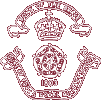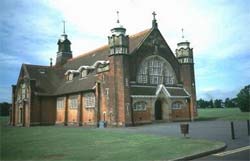


 |
 |
|
 |
||
| Navigation links at the bottom of this page | |||||||||||||||||||||
| On the subject of religion | |||||||||||||||||||||
| Two subjects considered taboo for discussion in polite society were religion and politics. This was particularly true in military messes as late as the 1950s. On the other hand there is ample evidence that these same sensitive subjects were, from the formation of Cromwell's New Model Army in the 1640s, woven into the fabric of military life and, therefore, beyond discussion. | |||||||||||||||||||||
Contemporary society is not so inhibited – on the understanding, however, that politics are best left to politicians. Those of us who research school history do not hesitate to draw frank conclusions from the data to be found in the admissions registers of the Duke of York's and Royal Hibernian schools. How else might we understand the past? It being the historian's duty to bring to the notice of readers all and any topics that affected the lives of past generations of Dukies, we bring interesting historical data to do with religion to readers' attention. |
 |
||||||||||||||||||||
One obvious conclusion to be drawn from the records is that a candidate's religion – and by inference that of his parents – was an important factor in determining whether or not he would enter the RMA, Chelsea, or the RHMS, Dublin. The reason for this conclusion is, oddly enough, that the data in the registers of both institutions complement one another to a remarkably close degree. This is despite the fact that many records of the RHMS are no longer in existence. Those that are available, when compared with the same period of those for the Duke of York's institution show indisputable statistical similarities. One must observe however that religious affiliation was not the determinant criterion governing admission. In the case of the RMA, religion was not an issue from the date of its opening on 29 August 1803 and for many years after. More precisely, because the registers do not record the religion of applicants until the 1870s the statement that 'religion was not an issue' is speculative. From the passing of the Catholic Emancipation Act of 1829 the situation in both institutions underwent a gradual change until the 1870s when each child's religion was recorded. If nothing else, the lack of registered religious affiliation implied that the matter was of little concern. On the other hand – and this is a factor – the 'Established Church' through the board of commissioners ruled the lives of all children in the Army's care, boys and girls (until girls were denied entry in the early 1840s). By 'Established Church' was meant, and still does mean, the Church of England or, in the case of the Protestant ascendancy in Ireland, the Church of Ireland. What was true for the RMA therefore was equally true for the RHMS. Religion was at the core of the curriculum throughout the military schools, including the regimental schools. The religious tenets taught were exclusively those of the Established Church. The Bishop of London had a permanent seat on the Board of Commissioners. He was directly responsible for specifying the subjects to be taught. Children attended church regularly, learned their catechism, and were brought up in 'a Christian environment', a contemporary philosophy that still applies to the life of the Duke of York's School. The Catholic Emancipation Act of 1829, meant to settle the battle of wills between the Roman Catholic Church and the Established Church, went some way to redressing the exclusion of those Roman Catholics from the legal, social and political life of the country. The Emancipation Act also changed the religious dynamic in many ways and led to a demand by influential persons that Roman Catholic children of the RMA be allowed to attend their own church. By the late 1850s, the commissioners and school authorities of institutions reached an accommodation that permitted the Roman Catholics to attend their own church for religious instruction and prayer. Many more years passed before it was deemed necessary to identify each boy's religion. The situation was more pronounced at the RHMS from which a return of students admitted and their religion was required by order of the House of Commons from the first day of January 1840. This is dealt with separately on the RHMS historical record (see 1844 Return). For the RMA, the day on which the first entry of a child's religion occurred was 27 August 1873, 70 years after the first children arrived at the RMA and two days short of the anniversary date 29 August 1803. No official explanation had been located as to why each boy's religion should be registered. One is left to speculate. By way of example, the admissions register for 1880 shows that in a school population of 441 there were 354 Protestants, 83 Roman Catholics, three Presbyterians and one Wesleyan. Each boy's religion was entered in the WO143/78 from January 1847. The previous WO143/27 Boys Index ledger did not include the boy's religion. As this was a copy of the ‘Lost Admissions ledger' or a summary, then this detail could well have been included in this earlier ledger. Entries in the admission ledgers of the RHMS show that a listing of each boy's religion began shortly before ledger PRO WO143/78 closed with the last entry in December 1877. This ledger covered the period January 1847 to December 1877. The new RHMS ledger included columns in which to record each entrant's religion as well as that of his mother and his father. This provides what might be termed an accurate 'pew state' from 1847 to 1897. From this data it is possible to identify the 'mixed marriages' that resulted from the presence of Protestant soldiers of regiments stationed in Ireland marrying women from among the predominantly Roman Catholic population of Ireland. |
|||||||||||||||||||||
|
|||||||||||||||||||||
The proportion of Roman Catholics to Protestants is the same for both institutions; i.e. 18 per cent of the children were Roman Catholics in both schools. In the 19th Century, Irish recruits made up more than 40 per cent of the British Army. What then explains the discrepancy in the higher proportion of Protestant to Roman Catholic entrants to both institutions? Did it mean that the orphan of a Protestant father had a better chance than a RC orphan had of gaining admission to one or other of the military schools? This would be hard to say, but the figures from the admissions registers for the period given would seem to indicate preferential treatment. By way of comparison, taking a sample page from a more recent admissions register (PRO WO143/70), the comparison of RCs to C of E boys is the same as for the pew states for 20 August 1880. That is, of the 41 names listed (sample page from PRO document WO143/70 – covering entries under the letter C) 30 are Church of England, 8 are Roman Catholics, 2 are nonconformists, and one failed to arrive; that is, the Roman Catholics represent 19 per cent of the whole, which is remarkably similar to the 'pew states' for 20 August 1880. In contrast to the earlier observation, that Irish nationals made up 40 per cent of the British Army during the 19th Century, we do not know what proportion of Irish nationals were in the British Army from, say, 1939 to 1945, the period of World War II covered by the sample page from WO143/70. |
|||||||||||||||||||||
| ||||||||||
|
© A. W. Cockerill 2011 Site Map Contact me | ||||||||||